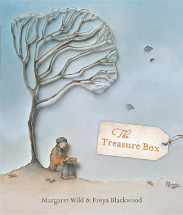The treasure box by Margaret Wild

Ill. by Freya Blackwood. Penguin, 2013. ISBN 978 0 670 07365 8
(Age: 6+) Highly recommended. Picture book. Reading. Children in
war. From the stunning cover to the words which follow Peter's journey from his war disrupted home to a new life, returning to
retrieve the treasure box left him by his father, this book will
resonate with all readers, young and old. Shadows of stories of
people seeking refuge, of disrupted lives, of people fleeing their
homes, of leaving all they love; crowd behind this tale, as Peter
digs up the treasure box, buried for safe keeping years before.
All the while, the background begs the reader to touch each page,
wondering at the three dimensional images presented by Freya
Lockwood. Her illustrations from cut out paper, fill the pages,
giving a shadowy effect to the story, impelling the reader to look
behind the words at the people and their lives as they trudge away
from war, die on the road to safety, find refuge in a new country,
but still have ties to their homeland.
The first double page presents a bombed street, showing that the
library has been bombed. Over the page pieces of pages from books
float across the paper, as we see Peter's father has the one book
that survived, the one he loved to read. As each page is turned, the
muted colours contrast with the bright red colour of the cover of
the book, shown to the son, kept safely in a box, and then passed on
to Peter as father dies. The little figures of the refugees huddled
into their blankets along the road is just one of the many haunting
images presented in this book. In a new city, Peter grows up,
eventually returning to the town and the tree where he buried the
box containing the book. Its importance becomes clear as he places
it on the library shelves where others will be able to borrow and
read it.
Blackwood's use of smaller images against which a cut out is placed
draws the eye in to look more closely at each image: her use of the
floating pieces of paper remind us of the indiscriminate nature of
war, the sepia colours of the houses and villages passed by the
refugees underline the displacement of so many people, her
contrasting images of the town and countryside when Peter is seeking
refuge and when he returns an older man, reflect the ephemeral
nature of war and that people survive, as do stories, the developing
colour reflecting people's optimism and hope for the future.
Blackwood has used torn pages from translated versions of
Gleitzman's Once series, and Hartnett's The Silver
Donkey, to fill the endpapers, using these again as the sky
and some of the foreground in the book.
For teachers looking at the impact of war on children, of the
importance of story and books, of passing on stories form one
generation to another, of resilience and determination, then this is
a stand out contribution to the books read in the classroom.
Fran Knight